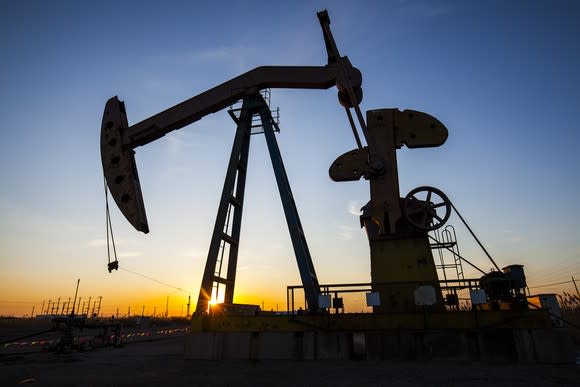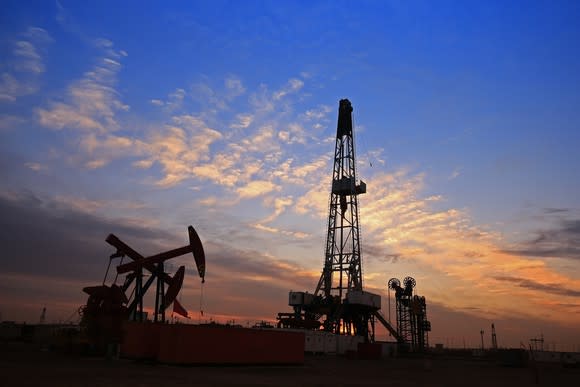These Are the Biggest Oil Producers in the United States
While many people assume Saudi Arabia is the world's largest oil producer, that's no longer the case. In 2017, the United States came out on top as the leading global producer of oil and other petroleum liquids. Overall, oil companies in the U.S. pumped out an average of 14.5 million barrels per day (BPD), according to the Energy Information Administration (EIA). That production level accounted for 15% of the world's total output that year, which was ahead of both Saudi Arabia (at 13%) and Russia (at 12%).
What's unique about the oil market in America is that it isn't dominated by one national oil company, as is the case for most of the members of OPEC. In Saudi Arabia, for example, Saudi Aramco is the nation's sole oil company, making it the largest oil-producing company in the world. In the U.S., on the other hand, hundreds of companies, including several foreign entities, operate producing wells. However, most of the largest oil producers in the states are headquartered in the U.S., which makes it easier for most U.S. investors to buy their stocks.

Image source: Getty Images.
Why America's oil resurgence is important for investors
Although the U.S. has quickly climbed up the global oil supply leaderboard, investors won't want to miss the fact that the country still has plenty of oil growth ahead of it. With a vast supply of oil still underground, America's oil production appears poised to continue rising in the coming years. According to a recent forecast by OPEC, America's production of oil from shale resources alone should increase from 7.4 million BPD in 2017 to more than 16 million BPD by the late 2020s. Add that growth to the potential for oil prices to rise back above $100 a barrel in the next few years, and U.S. oil stocks could fuel big-time gains for investors -- which is why investors should take some time to get to know the sector's leading oil companies.
Many investors tend to classify any company related to the oil industry as an oil stock. However, the sector has three parts: upstream, midstream, and downstream. Upstream companies are those that drill wells that produce oil and make most of their money selling that oil. That's why investors who are seeking oil-driven profits should focus their attention on upstream oil producers, since they have the potential to deliver the most gains as their production rises alongside crude prices.
How the U.S. became an oil-producing powerhouse
What's fueling America's oil production renaissance is the industry's ability to tap into the country's vast shale resources, areas where oil and gas saturate tight rock formations. Companies did this by combining two legacy technologies: horizontal drilling and hydraulic fracturing (fracking). This multistage process includes drilling a well a mile or more vertically before turning and drilling another mile or two horizontally, then pumping water and sand at high pressures to fracture the shale formation, unleashing the trapped oil and gas. These techniques have been the key to America's energy revival, which has the country on pace to smash 1970s oil production record of 10.044 million barrels per day (BPD).
The U.S. has seven main shale regions that are driving the bulk of the country's oil production growth:
The Anadarko in Oklahoma, which includes the STACK shale play
The Appalachia region through Pennsylvania, Ohio, and West Virginia, which includes the Marcellus shale and Utica shale
The Bakken shale in North Dakota and Montana
The Eagle Ford that runs through south Texas
The Haynesville shale in eastern Texas and northwest Louisiana
The Niobrara, which spans northern Colorado and western Wyoming and includes the Powder River Basin and DJ Basin
The Permian Basin, which stretches across western Texas and southeast New Mexico
Most of the country's largest oil producers operate in at least one of those shale regions.
Drilling down into America's largest oil producers
Here are the top 10 U.S.-headquartered companies:
The Biggest Oil Producers in the U.S. | Oil Production in 2017 | Natural Gas Liquids (NGLs) Production in 2017 | Total Liquids Production in 2017 |
|---|---|---|---|
Chevron (NYSE: CVX) | 442,000 BPD | 77,000 BPD | 519,000 BPD |
ExxonMobil (NYSE: XOM) | 416,000 BPD | 98,000 BPD | 514,000 BPD |
EOG Resources (NYSE: EOG) | 366,900 BPD | 100,600 BPD | 467,500 BPD |
ConocoPhillips (NYSE: COP) | 343,000 BPD | 69,000 BPD | 412,000 BPD |
Anadarko Petroleum (NYSE: APC) | 266,000 BPD | 95,000 BPD | 361,000 BPD |
Occidental Petroleum (NYSE: OXY) | 200,000 BPD | 55,000 BPD | 255,000 BPD |
Pioneer Natural Resources (NYSE: PXD) | 158,600 BPD | 55,000 BPD | 213,600 BPD |
Devon Energy (NYSE: DVN) | 114,000 BPD | 99,000 BPD | 213,000 BPD |
Marathon Oil (NYSE: MRO) | 133,000 BPD | 43,000 BPD | 176,000 PBD |
Hess (NYSE: HES) | 112,000 BPD | 36,000 BPD | 148,000 BPD |
Data source: Company reports. BPD = barrels per day. Liquids include oil and natural gas liquids (NGLs).
Let's drill down into five of these top oil producers. I've chosen these particular oil stocks because their focus isn't just on growing production but on building shareholder value, which makes them more likely to outperform their peers.

Image source: Getty Images.
Chevron: America's largest oil producer
While ExxonMobil might be the biggest U.S. oil stock, Chevron edges out the global oil giant as the largest oil producer in the country. Overall, Chevron produced 4.7% of America's oil in 2017 versus Exxon's 4.4%. One reason is that Chevron is more U.S.-focused: 30% of its oil production comes from the U.S. versus 22% for Exxon.
Chevron has taken a three-pronged approach to become the U.S. oil leader. First, it's the top oil and gas producer in California, where the company has its headquarters. It operates from three main fields in the San Joaquin Valley: Kern River, Midway-Sunset, and Cymric, some of which have been producing oil for more than a century. While output from these aging fields has declined over time, Chevron has leveraged new technology and techniques -- such as flooding the reservoirs with steam -- to increase their production.
Though California is important to Chevron, the company gets the largest portion of its oil production from the Gulf of Mexico, where it holds stakes in several large fields including Jack, St. Malo, Mad Dog, and Tubular Bells. Production from the region is on pace to expand in the next few years because Chevron has several major projects starting up, including Big Foot and Stampede, both of which started up in 2018, and the Mad Dog 2 project that should begin producing by 2021.
The third leg of Chevron's American oil platform is the midcontinent region, which includes oil and gas fields in Colorado, New Mexico, and Texas. The crown jewel is its land in the Permian, where it holds 1.7 million net acres across both sides of the Basin. Chevron has been producing oil and gas from the Permian since the early 1920s and recently hauled out its 5 billionth barrel. However, the company estimates that it's sitting on another 11.2 billion barrels of oil equivalent (BOE) in the Permian, which should provide it with years of growth.
It's that Permian oil growth engine that makes Chevron such a compelling stock. The company believes that the region will not only supply it with needle-moving production growth but expand its margins and profitability. In Chevron's view, its Permian Basin position can help fuel 30% compound annual growth in free cash flow through 2020, which would lead its peer group. That high-octane expansion in free cash flow will give Chevron more money to return to its shareholders via dividends and share buybacks, which could create significant value for investors.
EOG Resources: America's leading shale producer
While EOG Resources might only be the third-largest oil producer in the U.S., it's by far the country's leader in extracting oil from tight shale formations. During the fourth quarter of 2017, EOG produced an average of 479,000 BPD from shale formations across the lower 48 states, more than double the level of its next largest peer. Overall, 90% of EOG's production is stateside, including 99.5% of its oil output.
The largest portion of that production came from the Eagle Ford, where the company is the top oil producer, pumping out an average of 157,000 BPD in 2017. The company estimates that it can drill another 7,200 wells in the region, which position it to unleash 3.2 billion barrels of oil equivalent resources in the future, with roughly 85% of that output likely to be oil and NGLs.
EOG Resources' second-largest region is the Permian, where production averaged 91,000 BPD in 2017. This location could surpass the Eagle Ford as EOG's largest producer in the coming years, since it has 6,885 remaining drilling locations that could unlock 6.5 billion BOE of resources.
Finally, EOG holds a large acreage position across the Rocky Mountain area, which includes land in the Bakken, DJ Basin, and Powder River Basin, where it produced 66,000 BPD last year. While the Bakken has long been an important region for EOG, the Powder River Basin is emerging as a very compelling area for the company after it discovered 1.9 billion BOE of additional resources in early 2018, boosting its total in that region to 2.1 billion BOE.
EOG's large supply of remaining drilling locations gives the company the resources to grow its U.S. oil production at a 15% compound annual growth rate (CAGR) through 2020, assuming oil averages $50 a barrel, and by up to a 25% CAGR if crude is at $60 a barrel. That high-octane growth rate could eventually enable the company to surpass its big oil rivals and become the country's top oil producer. Meanwhile, it will supply the company with more cash flow, which it intends on using to grow its dividend at a high rate in the coming years. That fast-paced dividend growth could be EOG's ticket to delivering market-beating returns, given the historical outperformance of the best dividend growth stocks.
ConocoPhillips: Combining the old with the new
ConocoPhillips produced 832,000 BPD of oil and NGLs in 2017, with roughly half of that coming from the U.S. The oil and gas giant pumped about 231,000 BPD of those liquids (or 56%) out of the lower 48 states, with the rest coming from Alaska, where it's the largest oil producer.
Alaska was once the crown jewel of the U.S. oil industry, and at its peak in 1988, the state produced roughly 2 million BPD. Output has steadily declined since then due in part to higher taxes, which disincentivized drilling, causing it to fall to less than 600,000 BPD.
However, a shift in the state's tax policy a few years ago has reinvigorated exploratory drilling in Alaska. ConocoPhillips has taken advantage of this change to make several significant discoveries in recent years. Because of those oil finds, as well as a string of recent acquisitions, the company's output in Alaska could rise to more than 300,000 BPD within the next 10 years.
Meanwhile, ConocoPhillips also holds a vast onshore land position in the lower 48 states, controlling 10.4 million net acres across much of the country's midsection. However, the company's focus is on its positions in the Eagle Ford, Bakken, and Permian, which it has dubbed the "big three." Like EOG Resources, the company's largest producer is the Eagle Ford, followed by the Bakken and the Permian. The company currently has big plans for the big three. While it does expect to hold its Bakken production roughly flat over the next three years, it sees output from the Permian expanding at a 60% CAGR, while its Eagle Ford output is on pace to rise at a 25% CAGR.
What's unique about ConocoPhillips' expansion plan is that the company is blending the old (Alaska) with the new (shale) to grow its U.S. production. While this strategy won't give the company enough fuel to challenge Chevron for the lead, nor compete against EOG's growth engine, it does expect to steadily increase its production in the U.S., which will provide it with more cash flow to pay its investors through additional share repurchases and a steadily rising dividend.

Image source: Getty Images.
Pioneer Natural Resources: A highly focused oil growth stock
Pioneer Natural Resources is the only oil stock on the top 10 list that doesn't have any international operations. Not only that, but the company is currently selling off most of its domestic assets -- including its Eagle Ford position -- so that it can focus entirely on its acreage in the Midland Basin side of the Permian, where it's by far the largest producer. As of June 2018, the company's output in the Midland averaged 332,000 BOE/D, which was nearly triple the size of that of its next largest rival.
Pioneer expects to expand its lead in the coming years as it taps into its vast resource position, which includes 750,000 total acres and more than 20,000 drilling locations. The company is currently in the early stages of a 10-year strategic plan to grow its oil and gas output to more than 1 million BOE/D by 2026, including 700,000 BPD of oil. That forecast implies a more than 20% CAGR in its oil production for a full decade.
While focusing solely on the Permian has its advantages, some potential pitfalls could derail Pioneer's ambitious growth plan. One noteworthy issue is that the region has been growing faster than midstream companies can build the infrastructure necessary to support production. Currently, there isn't enough pipeline capacity to transport all the Permian's oil, which is weighing on prices in the area. That problem hasn't yet impacted Pioneer because it has been proactive in locking up capacity on pipelines. Meanwhile, it seems to have gotten out ahead of other potential issues by partnering with service and logistics companies to secure the sand it needs for fracking wells and the natural gas processing capacity necessary to maximize the value of its NGL production. However, this is an area that investors should watch closely since a failure to plan could impact the company's growth ambitions.
Those risks aside, what makes Pioneer such a compelling oil stock to consider buying is that the company believes its fast-paced production growth will fuel equally rapid cash flow growth. Management believes it can expand cash flow at a 20% annual clip for a decade, which is elite-level growth that could give its stock the fuel to vastly outperform the market.
Marathon Oil: A four-pronged shale attack
Marathon Oil has undergone a dramatic transformation over the past several years. The company has unloaded $4.5 billion in assets, mainly in Canada and Libya, to refocus its attention on resource plays across the U.S., using that cash to bolster its position in the STACK while adding land in the Permian Basin.
With those additions, the company now controls four U.S. growth engines, which also includes positions in the Eagle Ford and Bakken. The Eagle Ford was the company's largest producing area in 2017, at 80,000 BPD, followed by the Bakken at 52,000 BPD, Oklahoma (which includes the STACK) at 29,000 BPD, and the recently acquired Permian at just 5,000 BPD.
Looking ahead, Marathon expects to invest heavily in drilling across these four regions, which should fuel fast-paced growth. The company's most recent forecast sees output in its four U.S. resource plays expanding at a blistering 28% to 32% pace by the end of 2018 compared to where it was at the end of 2017. It's already delivered impressive results through the first part of 2018, with its oil output in the Bakken surging 14% during the second quarter alone.
Marathon's multipronged shale growth strategy gives it the resources and flexibility to grow at a high rate in the coming years. That fast-paced oil production growth should drive its cash flow higher, which would give it more money to return to shareholders through its share repurchase program.
A great time to consider buying U.S. oil stocks
The U.S. oil industry's ability to unlock the country's shale resources has unleashed a gusher of oil production that has turned the country's energy fortunes around. While the industry faced a setback when crude prices crashed a few years ago, it has quickly recovered because oil companies can tap these oil riches for low costs. As a result, the U.S. oil industry appears poised to cash in as oil prices continue their recovery in the coming years. That's why investors should take a closer look at the country's largest oil companies, since they could produce a gusher of profits as production grows and oil prices rise.
More From The Motley Fool
Matthew DiLallo owns shares of ConocoPhillips. The Motley Fool has no position in any of the stocks mentioned. The Motley Fool has a disclosure policy.

 Yahoo Finance
Yahoo Finance 